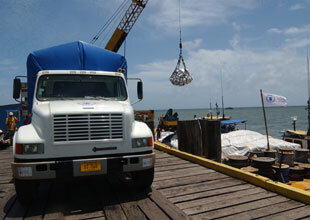WFP、ハリケーン・フェリックス被災者に対し緊急支援を要請 (和文要約、本文は英文)

マナグア発 − WFPは9月13日、ニカラグア北部で猛威をふるったハリケーン・フェリックスの被災者10万人を支援するため、緊急支援に向けて1700万米ドル(約20億円)の拠出を要請すると発表した。
被害を受けた1万戸の家屋のうち80%は全壊。井戸5200基が汚染され、野外トイレ6000基も損壊した。下痢の症状を示す子どもたちが増えており、衛生状態の劣化が懸念されている。また、ココナッツ、バナナ、マンゴー、米など人々の基礎的な食糧となる作物が大きな被害を受けた他、耕作地の塩害により12月期の収量も大幅に減少すると予測されている。
WFPはハリケーン上陸当日から緊急支援を続けており、先週末には151トンの食糧(1万5000人に対する20日分)がニカラグア北部のビルウィの港へ届けられた。今後3ヶ月間は、緊急時用の割当で配給を行い、その後復興支援へと移行する予定だ。
被災者の数は遠隔地からの情報が入るに従い増加しており、今回のハリケーンの凄まじさが次第に明らかになってきている。
13 September 2007
WFP TO APPEAL FOR US$17 MILLION TO ASSIST “PUMMELLED” HURRICANE FELIX VICTIMS
MANAGUA – The United Nations World Food Programme (WFP) today announced plans to issue a US$17 million emergency appeal to assist an estimated 100,000 victims, as rescue crews were reported stunned by the intensity of the destruction wrought by Hurricane Felix in northern Nicaragua.
“The numbers of people seriously affected continues to grow while at the same time, as more information comes in from this remote region, we realise just how violent and destructive Hurricane Felix really was,” said WFP Country Director William Hart.
“Not only have entire villages up and down the coast been pummelled and flattened into the ground, but extensive damage has also been reported among those living as much as 100 km back from the coastline.”
Initial reports indicate that of the almost 10,000 homes affected by the violent Category Five hurricane, 80 percent were completely destroyed. Almost 5,200 wells were contaminated and 6,000 latrines destroyed. Diarrhoea among children is increasing and heavy rainfall is creating unsanitary conditions that have raised fears of worsening health conditions.
Hurricane Felix also ripped out large quantities of coconut, banana and mango trees, depriving inhabitants of basic foods needed to cope. The upcoming harvest of rice and other vital crops has been lost and, as a result of salt water damage to fields, it is expected that December’s harvest may be lost or severely reduced.
Under the six-month WFP emergency operation, which is part of a consolidated appeal of UN agencies being announced today, WFP will provide a general distribution of emergency rations for the first three months, followed by food support for rehabilitation activities. These activities are likely to be extended for an additional period once a more detailed assessment of the region’s needs is completed.
“The victims of this catastrophe are among the poorest and most vulnerable people, not just in Nicaragua but in the whole Latin American region,” Hart said. “As our staff arrive with supplies, it is clear they have been left with literally nothing. Everything is destroyed and their lives are in pieces. What we are discovering as we visit these remote areas is a desperate swathe of humanity that has been invisible to the outside world, and which now more than ever needs the help of outsiders.”
Meanwhile, WFP emergency feeding operations continue. Over the weekend, two ships carrying a combined total of 151 metric tons of food (enough for 15,000 people for 20 days) arrived in the battered coastal port of Bilwi (formerly Puerto Cabezas) after a two-day journey along the Escondido River. Bilwi has been cut off from overland transport after a key bridge was destroyed by Felix.
About 14 tons of the food (enough to feed 1,550 for 18 days) was then transported by two United States Air Force helicopters to the town of Raiti, one of more than 100 Miskito indian communities along the coast. Without the helicopters, which have established an air bridge in the area, the journey would have taken over one week.
